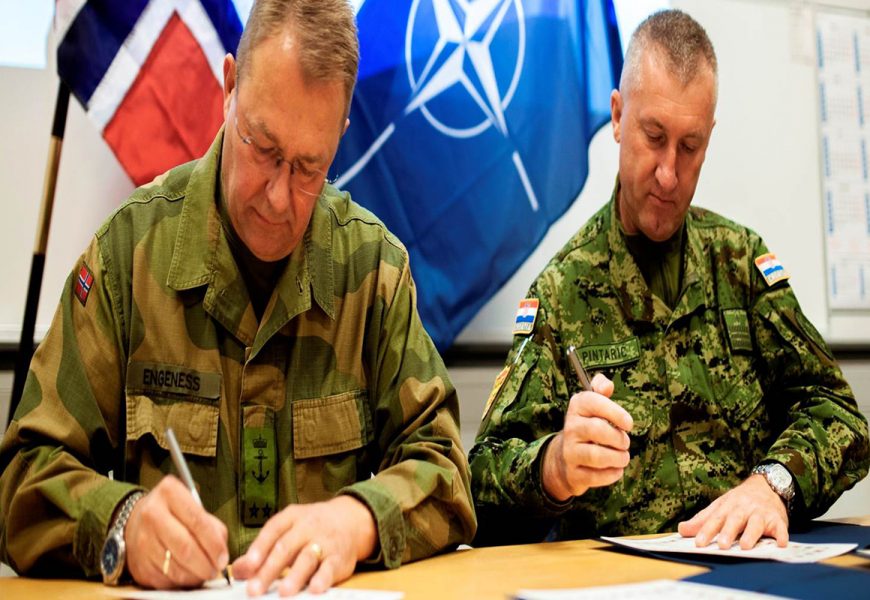Croatian general officer heads JLSG in “Trident Juncture 18”
The Commander of the Joint Logistics Support Group (JLSG) engaged in NATO’s “Trident Juncture 18” Exercise, was Brigadier General Darko Pintarić (Croatian Army).
JLSG is a logistic unit responsible for organisation and securing of the movement of the forces, vehicles and supplies for all Exercise participants from their entry in Norway to the destination, for the supply of idnividual force elements and for the return of the units to their home bases following the exercise.
Along with Brigadier General Darko Pintarić,(presently assigned to a duty in the Allied Joint Force Command Naples), two members of the Support Command of the Croatian Armed Forces (Captain Vedran Barić and Captain Tomislav Komjetan) were also assigned in the Joint Logistic Support Group Headquarters (based in Sessvollmoen, Norway).
“As the Commander of the JLSG, I am very proud of the important role of logistics in planning and carrying out exercises, as well as all the members of the JLSG Command and Unit, who have carried out their tasks professionally and responsibly” General Pintarić said.
Brig. Gen. Pintarić said the JLSG (composed of 1,000 personnel) displayed the true collective spirit of NATO.
“It can be asserted that the Logistic Group has successfully conducted its first task, which comprised the reception of the personnel, vehicles and the entire equipment of all participants in the agreed maritime and airport, railway stations and border crossings as well as the organisation of accomodation and messing, the fuel supply and the organisation of transportation or autonomous movement to the final locations in Norway, where the participating units kicked off the LIVEX.

Within less than a month the major component of the forces (seven brigades) have reached their final locations in the territory of Norway concurrently and in a synchronised manner without intefering with the daily life of the local population, as planned.The logistic service has demonstrated NATO to be capable of deploying its forces rapidly in the event of the need to defend a member nation. NATO’s concept of Joint Logistic Support Group has been implemented and tested. It should be stressed that “Trident Juncture” has been the first time that logistic tasks have been implemented in the field,in a NATO member nation’s territory in a collective defence scenario“ said Brig. Gen Pintarić.
During the conduct of the Exercise the Joint Logistic Support Group (engaged from August through December) was also in charge of the co-ordination of logistic support at the highest level, for storage and distribution of fuel to the brigade-level logistic units and transportation and replenishment of the fuel for helicopters at outposts, as well as for co-ordinated and synchronised return of the participating forces to their home bases following the Exercise.
“Trident Juncture 18″ has engaged a total of 30 members of the Croatian Armed Forces who have committedly and responsibly conducted their tasks, representing gracefully the Croatian Armed Forces and the Republic of Croatia in the Exercise”.
The members of the Joint Logistic Support Group, headed by Brigadier General Pintarić also attended the Distinguished Visitor Day of the Exercise “Trident Juncture 18” held in Byneset, Norway on 30 October 2018 that was attended by NATO Secretary General Jens Stoltenberg, the Commander of the Allied Command Operations (ACO) and of the U.S.European Command (EUCOM) General Curtis Scaparrotti, the Trident Juncture 18 Commander, Admiral James G. Foggo III, (Commander of the Allied Joint Force Command Naples) and many other senior civilian and military officials, including the Chief of the General Staff of the Croatian Armed Forces, General Mirko Šundov.
The Exercise “Trident Juncture 18“ conducted in Norway from 25 October – 7 November 2018 engaged some 50,000 members of armed forces from 31 NATO and partner nations, equipped with 250 aircraft, 65 vesels (including the U.S. sea carrier “Harry S. Truman” and some 10,000 motor vehicles.
[ngg src=”galleries” ids=”3128″ display=”basic_thumbnail”]
